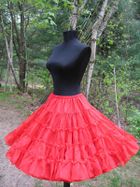Chemise
The term chemise can refer to the classic smock or shift, or else can refer to certain modern types of women's undergarments and dresses. In the classical usage it is a simple garment worn next to the skin to protect clothing from sweat and body oils, the precursor to the modern shirts commonly worn in Western nations.
A petticoat or underskirt (picture at left) is an article of clothing for women; specifically an undergarment to be worn under a skirt, dress or sari. The petticoat is a separate garment hanging from the waist (unlike the chemise at the right).
In historical contexts (sixteenth to mid-nineteenth centuries), petticoat refers to any separate skirt worn with a gown, bedgown, bodice or jacket; these petticoats are not strictly speaking underwear as they were made to be seen.
In both historical and modern contexts, petticoat refers to skirt-like undergarments worn for warmth or to give the skirt or dress the desired fashionable shape. In this context a petticoat may be called a waist slip or underskirt (UK) or half slip (US), with petticoat restricted to extremely full garments. Petticoat can also refer to a full-length slip in the UK, although this usage is somewhat old-fashioned.
Etymology
Chemise is a French term (which today simply means shirt). This is a cognate of the Italian word camicia, and the Spanish / Portuguese word camisa (subsequently borrowed by Hindi / Urdu), all deriving ultimately from the Latin camisia. The English called the same shirt a smock and the Irish called it a léine (pronounced /ˈleɪnjə/).
The history of the chemise
The chemise seems to have been developed from the Roman tunica and first became popular in the European Middle Ages. Women wore shifts or chemises underneath their gowns or robes; men wore chemises with their trousers or braies, and covered the chemises with garments such as doublets, robes, etc. In those times, it was usually the only piece of clothing that was washed regularly.
In Western countries, women's shifts did not fall out of fashion until the early 20th century, when they were generally replaced by brassieres, panties, girdles, and full slips.
Men's chemises may be said to survive as the common T-shirt, which still serves as an undergarment. The chemise also morphed into the smock-frock, a garment worn by English laborers until the early 20th century. Its loose cut and wide sleeves were well adapted to heavy labor. The name smock is nowadays still used for military combat jackets in the UK, whereas in the Belgian army the term has been corrupted to smoke-vest.
Examples of Sleepwear
| This article is about Lingerie and undergarments Main article and index is at Lingerie |
Chat rooms • What links here • Copyright info • Contact information • Category:Root

